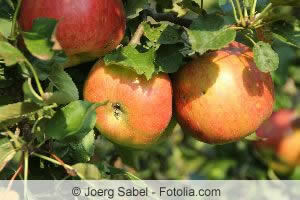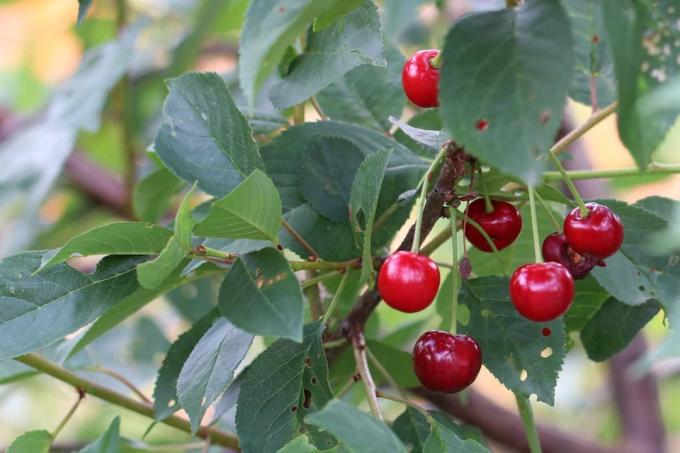

Table of contents
- Plant pruning in spring
- education in summer
- Education in the second spring
- Maintenance cut in summer
- Conservation in the third spring
- Basic framework for trellis fruit
- Pros and cons of trellis fruit
- Suitable fruit varieties
- Conclusion
Even if some cannot imagine it, espalier fruit can also be very productive, provided it is cared for and properly blended. Before you can even trim the trees, a suitable trellis or Scaffolding, for example made of wood or metal, can be erected to which the shoots are attached and the tree can be trained to form an attractive trellis. The pruning of trellis fruit includes a planting pruning, several training pruning to build up main branches and fruit shoots, and maintenance pruning to build up the crown.
Plant pruning in spring
The so-called pruning, with which training to form a trellis begins, usually takes place in the spring after planting. Even if the sapling is planted in autumn, the pruning should only be carried out in the following spring. To do this, select the two strongest from the lowest side branches and cut them by about a third or a half. to a downward eye. Then they are attached to the lowest horizontal tension wires. These two side branches form the so-called leading branches and thus the first level of the trellis. All other side branches that grow diagonally or vertically are cut off, except for small stubs or stumps. except for three leaves. The vertical main shoot, also known as the leader or middle shoot, is slightly shortened just above an outward-pointing bud.
Tip:
Only elastic materials should be used to attach the leading branches, e.g. B. Binding willow or tubular tape made of PVC. Rigid materials such as wire or similar should be avoided, as they would grow in over time and cause considerable damage to the plant.
education in summer
The planting cut is followed in July by the next training cut, which serves to build up both the main branches and the fruit shoots and forms the second tier of branches. As with the pruning, choose two strong side shoots and fix them to the trellis at an angle of about 45 degrees. Over the course of the summer, these new leaders are gradually lowered until they are in a horizontal position. Small shoots that grow steeply upwards and young shoots that have formed on the main shoot are removed. In addition, smaller side branches are shortened to 5-6 leaves and the lower main branches are pruned.
Education in the second spring
The tree now has two well-developed branches. As with pruning in summer, all shoots that grow vertically upwards are removed. Then the tips of the leading branches of the second branch level are cut off again. This should encourage branching and budding of the trellis. Now all the shoots that have formed between these two levels, as well as the fruiting wood of the main branches, are shortened to about four fruiting buds. The fourth tier can be formed with the side shoots from the second branch tier.
Tip:
The shoots that later develop and bear flowers and fruit are called fruit wood. Fruit buds can be recognized by the fact that they are usually thicker than leaf buds.
Maintenance cut in summer
- The maintenance cut follows the planting and training cut.
- The training pruning should create a balanced relationship between fruit and main branches.
- An even crown structure should be achieved and the fertility of the fruit trees should be improved.
- Pruning takes place between June and August.
- All young shoots on the main shoot are cut to approx. 20 cm back.
- This also applies to the new shoots on the leading branches.
- This cut is intended to prevent the branches growing vertically upwards from becoming too strong.
- New shoots that grow steeply upwards directly on the main shoot are removed completely.
- During this time any competitive instincts should be continuously removed.
Conservation in the third spring
In the third spring, a so-called peg pruning is performed, during which old and strong branched fruit whorls are cut back along the individual branch levels, except for 3-4 buds. However, this has the consequence that significantly fewer fruit buds are formed and, as a result, the yield is also lower. But don't worry, the fruits are larger and the quality of the fruits is generally much better.
Basic framework for trellis fruit
In order to form the trellis, an appropriate framework made of wood, metal or tension wires must be set up before planting. Ideally, the distances between the individual wires and rods should be approx. be 40 cm. The ideal place for a trellis is in front of a house wall facing west or south. This location offers good wind protection and both direct (sun) and indirect heat radiation. There should always be a sufficient distance of at least 10 cm between the trellis and the house wall in order to ensure sufficient ventilation and good development of the plant.
The lowest branches should be at a height of about 40-50 cm. Once the scaffolding is complete, you can plant and trim the plants. When bending the shoots, you have to pay attention to the right time, because the more immature the shoots are, the more flexible they are. This is best between May and July. They are easiest to bend about 10-20 cm behind the tip. Incidentally, trellis trees can be raised in different forms. In addition to the horizontal, the most common form, there is the U or V trellis as well as the fan trellis and a special form, the so-called palmette.
Tip:
It is best to buy trellis fruit in the tree nursery and make sure that the tree has the shortest possible trunk so that the lowest row of branches or Astetage is not too high.
Pros and cons of trellis fruit
In addition to young plants that you can train yourself to form a trellis, the trade also offers perennial trellises that have already been grown. These have the advantage that they can be harvested earlier. But espalier fruit also has some other advantages. Compared to half and standard trees, they require much less space. With trellis u. a. House walls are greened, which also has an aesthetic effect. Free-standing trellises can be used very well as a property boundary, provided they are properly trimmed or trimmed. brought up, so that there is also a certain stability. Depending on the cut and the duration of treatment, training to form a trellis can significantly reduce the growth of strong-growing fruit trees. The shape of the crown remains clear and the better lighting and ventilation of the entire plant favors the formation of flower buds for the next year. Otherwise, the right cut will have a positive effect on the quality of the fruit in terms of ingredients and coloring and will ensure less susceptibility to disease. The only disadvantage of trellis fruit is actually the cut, because it is a bit time-consuming.
Suitable fruit varieties
In principle, all apple, pear and cherry varieties are suitable for growing as a trellis tree, they are the classics, so to speak. But apricots, plums and peaches are also suitable for this form of training and even berry bushes such as gooseberries, raspberries, currants or blackberries. However, apples and pears are still the most commonly grown espalier fruit. Among the apples, for example, the Elstar variety, the red Boskoop and the Canada reindeer are particularly popular and among the pears, the Clapp's Darling, the Delicious from Charneau, the Williams Christ and the Conference. If you want to grow your dream trellis yourself, you should make sure when buying that the grafting has taken place on a slow-growing rootstock.
Tip:
Rootstock M9 or M27 is recommended for apples and quince A for pears.
Conclusion
Trellis fruit is an interesting and, above all, space-saving alternative to conventional fruit trees. The easiest way is certainly to get a trellis that has already been drawn up from the tree nursery. However, if you don't shy away from the effort, you can draw your own trellis. Above all, you should pay attention to a suitable grafting base and a trunk that is as short as possible. You should also know that several cuts a year are required to build up a corresponding trellis, which serve to build up the framework with leading and fruiting branches and the crown structure. Otherwise, sufficient distances to house walls should be ensured in order to ensure good rear ventilation. Under these conditions, nothing should stand in the way of an early harvest of delicious fruit.
 garden editorial
garden editorial I write about everything that interests me in my garden.
Learn more about orchard care

Sour cherry - care instructions: Tips for the morello cherry
The sour cherry (Prunus cerasus) is ideal for smaller gardens because it grows small or shrub-like. Experts have a few tips to ensure that planting and harvesting works.

These 20 trees fertilize themselves | fruit trees
When cultivating fruit trees, pollination is an important aspect. Without them, fruit trees will not bear fruit, resulting in a failed harvest. Small gardens or balconies in particular are not suitable for several specimens. In this case, you should rely on self-pollinators.

Pruning a plum tree – instructions | When is the best time?
Pruning a plum tree is essential to ensure the highest possible yield for years to come and to keep the crop healthy. But when is the best time to do this and how should the blending be done? We tell.

Maintain espalier fruit trees | 5 tips on planting distance & care
Espalier fruit trees are an ornament for every garden and enliven unadorned walls and walls. It is true that creating it is very labor-intensive, but the effort is rewarded with a decorative appearance and sweet fruits. Certain factors must be taken into account when it comes to care and a sufficient planting distance.

Fruit tree diseases: recognizing common diseases
There is hardly a garden without fruit trees. They look splendid, give us shade and their fruits. Unfortunately, diseases sometimes spread. They can threaten the harvest and even the life of the tree. What are the clear signs?

The Best Fruit Tree Fertilizers - Basics of fruit tree fertilization
In order for fruit trees in the home garden to grow healthy and strong and to bear a variety of fruits, a balanced supply of nutrients must be guaranteed. In this article you will find out when, with what and how best to fertilize your fruit trees.



